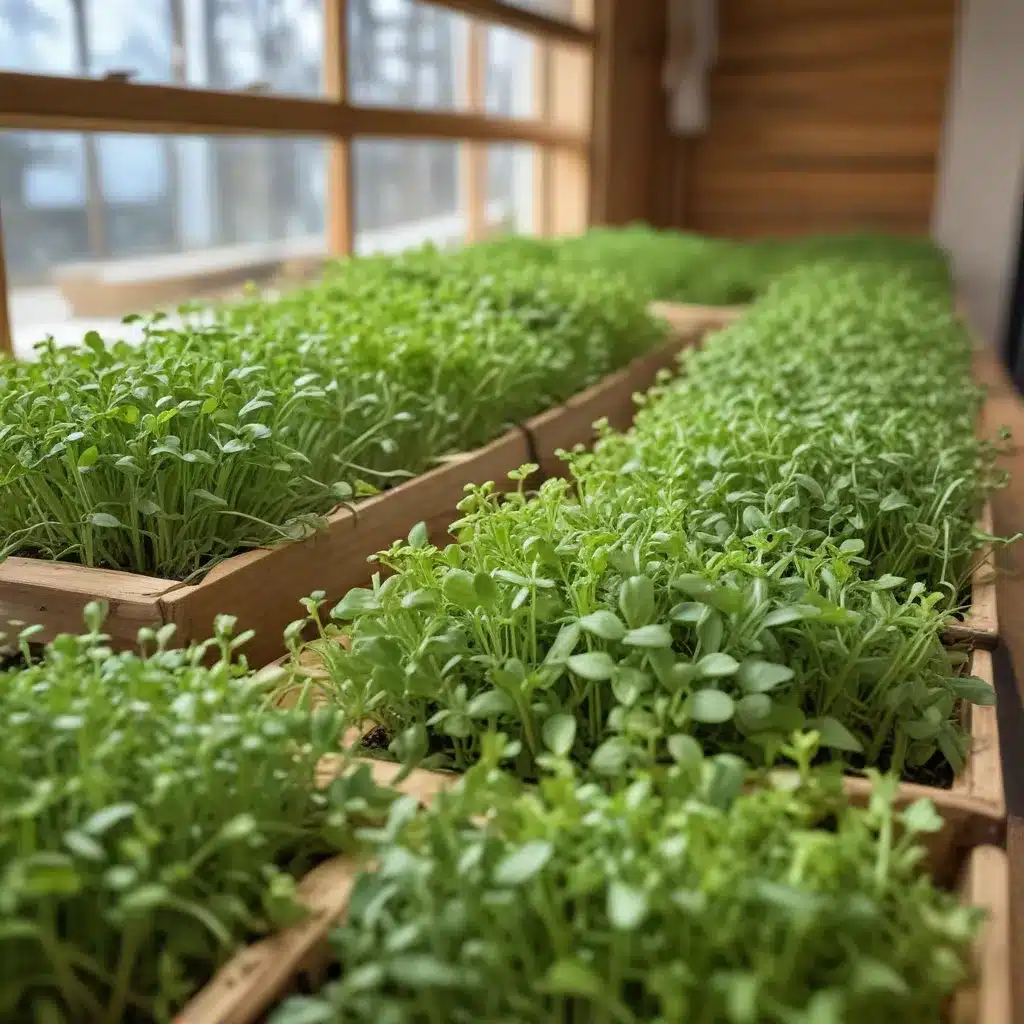
Nestled within the rolling hills of our beloved Crooked Pines Farm, a new adventure in indoor gardening has been taking root. Our team of dedicated farmers and educators has been exploring the wonderful world of microgreens – those petite, flavor-packed plants that are quickly becoming a culinary sensation. Join us as we dive deep into the art of mastering microgreens and discover how you can grow your own nourishing mini-crops, right in the comfort of your own home.
What are Microgreens?
Microgreens are the young, tender seedlings of various vegetables, herbs, and even some flowers. Unlike their fully mature counterparts, microgreens are harvested just a few weeks after germination, when they’ve developed their first set of true leaves. Despite their diminutive size, these miniature marvels pack a powerful nutritional punch, often containing higher concentrations of vitamins, minerals, and antioxidants than their larger, adult versions.
At Crooked Pines, we grow a wide variety of microgreen species, from the peppery tang of radish and the earthy sweetness of beet to the delicate, herbaceous notes of basil and chives. Each type offers its own unique flavor profile and visual appeal, making them a versatile addition to any kitchen or classroom.
Growing Microgreens Indoors
One of the best things about microgreens is that they can be grown year-round, right in your own home. Our team has perfected the art of indoor microgreen cultivation, and we’re excited to share our techniques with you.
Choosing the Right Growing Medium
To get started, you’ll need a shallow, well-draining container or tray, and a high-quality growing medium. At the farm, we prefer to use a sterile, nutrient-rich potting mix or a hydroponic growing mat to provide the perfect foundation for our microgreens.
Seed Selection and Sowing
Next, it’s time to choose your seeds. While you can certainly experiment with a wide range of microgreen varieties, we recommend starting with some of the more common and easy-to-grow options, such as sunflower, pea shoots, or broccoli. Gently sow the seeds evenly across the surface of your growing medium, taking care not to overcrowd them.
Lighting and Temperature Requirements
Microgreens thrive in bright, indirect light, so be sure to place your growing tray in a sunny spot or under a grow light. We’ve found that a consistent temperature between 65-75°F is ideal for optimal growth and development.
Cultivation Techniques
Watering and Moisture Management
Proper watering is crucial for healthy microgreens. Keep the growing medium consistently moist, but avoid overwatering, which can lead to mold or disease. We recommend using a spray bottle or a gentle misting system to ensure even distribution of water.
Harvesting and Storage
The waiting game is over! Once your microgreens have reached the desired size, typically 7-14 days after sowing, it’s time to harvest. Gently snip the stems at the soil line, being careful not to disturb the roots. Store your fresh microgreens in the refrigerator, wrapped in a damp paper towel or in a sealed container, to maintain their crispness and flavor.
Troubleshooting Common Issues
As with any growing endeavor, there may be some challenges along the way. Keep an eye out for pests, mold, or signs of nutrient deficiency, and be ready to adjust your watering, lighting, or temperature as needed. Our team is always here to offer guidance and help you troubleshoot any issues that may arise.
Microgreens in the Kitchen
Culinary Uses of Microgreens
From vibrant salads and artful garnishes to nutrient-dense smoothies and sandwiches, the culinary possibilities with microgreens are endless. At Crooked Pines, we love to incorporate these delicate greens into a wide variety of dishes, showcasing their versatility and flavor.
Incorporating Microgreens into Recipes
The key to successfully using microgreens in the kitchen is to think of them as you would any other fresh herb or leafy green. Toss them into salads, sprinkle them over roasted vegetables, or use them to add a pop of color and texture to your favorite soups and stews. Their delicate nature also makes them an ideal topping for avocado toast, omelets, or even your morning porridge.
Flavor Profiles of Different Varieties
Each microgreen variety has its own unique flavor profile, so be sure to experiment and discover which ones you and your family enjoy the most. The radish microgreens offer a peppery kick, while the beet microgreens impart a earthy, sweet essence. The basil microgreens lend a fragrant, herbal note, and the chives add a subtle, onion-like taste.
The Crooked Pines Approach
Sustainable Growing Practices
At Crooked Pines Farm, we pride ourselves on our commitment to sustainable and eco-friendly growing practices. Our indoor microgreen operation is no exception – we use organic, non-GMO seeds, recycle our growing medium, and employ water-efficient irrigation systems to minimize our environmental impact.
Community Engagement
Sharing our knowledge and passion for microgreens is an integral part of our mission at Crooked Pines. We regularly host hands-on workshops and farm nature exploration activities, inviting local families and school groups to learn about the wonders of these miniature marvels. By engaging with our community, we hope to inspire the next generation of urban gardeners and healthy eaters.
Challenges and Lessons Learned
Of course, our journey with microgreens hasn’t been without its challenges. We’ve had to navigate issues like pest management, temperature fluctuations, and inconsistent germination rates. But through it all, we’ve learned valuable lessons that have helped us refine our growing techniques and share our knowledge with others.
Whether you’re a seasoned gardener or a curious novice, we invite you to join us in mastering the art of microgreen cultivation. From the nutritional benefits to the culinary delights, these tiny, power-packed plants have the potential to transform the way you think about growing and eating. So, let’s get growing and unlock the hidden potential of microgreens, right here at Crooked Pines Farm.


